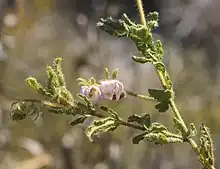Thomasia cognata
Thomasia cognata is a species of flowering plant in the family Malvaceae and is endemic to the south-west of Western Australia. It is a compact, multi-stemmed shrub with wrinkled, narrowly oblong to elliptic leaves and pale pink flowers.
| Thomasia cognata | |
|---|---|
 | |
| Near Wedge Island | |
| Scientific classification | |
| Kingdom: | Plantae |
| Clade: | Tracheophytes |
| Clade: | Angiosperms |
| Clade: | Eudicots |
| Clade: | Rosids |
| Order: | Malvales |
| Family: | Malvaceae |
| Genus: | Thomasia |
| Species: | T. cognata |
| Binomial name | |
| Thomasia cognata | |
Description
Thomasia cognata is a compact, multi-stemmed shrub that typically grows to 0.1–0.7 m (3.9 in – 2 ft 3.6 in) high, 0.5–1 m (1 ft 8 in – 3 ft 3 in) wide and has its stems covered in scattered, star-shaped hairs. The leaves are narrowly oblong to elliptic, 10–40 mm (0.39–1.57 in) long and 3–10 mm (0.12–0.39 in) wide on a petiole 2–3 mm (0.079–0.118 in) long. The edges of the leaves are wavy, the surfaces covered with a few star-shaped hairs. There are leaf-like stipules 6–8 mm (0.24–0.31 in) long at the base of the petioles, but that are shed early. The flowers are arranged in racemes of 2 to 8 up to 80 mm (3.1 in) long, each flower on a pedicel 3–4 mm (0.12–0.16 in) long, with bracteoles 4–6 mm (0.16–0.24 in) long at the base. The sepals are pale pink to purple, 7–8 mm (0.28–0.31 in) long, the petals about 1 mm (0.039 in) long, the style no longer than the stamens.[2][3]
Taxonomy and naming
Thomasia cognata was first formally described in 1845 by Ernst Gottlieb von Steudel in Lehmann's Plantae Preissianae from specimens collected on Rottnest Island in 1839.[4][5] The specific epithet (cognata) means "related by birth", referring to its similarity to other species.[2][6]
Distribution and habitat
This thomasia grows on coastal limestone and sand dunes from near the Murchison River and south to Albany, then east to the east of Esperance in the Esperance Plains, Geraldton Sandplains, Jarrah Forest, Swan Coastal Plain and Warren bioregions of south-western Western Australia.[2][3]
Conservation status
Thomasia cognata is classified as "not threatened" by the Western Australian Government Department of Biodiversity, Conservation and Attractions.[3]
References
- "Thomasia cognata". Australian Plant Census. Retrieved 1 January 2023.
- Blake, Trevor L. (2021). Lantern bushes of Australia ; Thomasias & allied genera : a field and horticultural guide. Victoria: Australian Plants Society, Keilor Plains Group. pp. 16–17. ISBN 9780646839301.
- "Thomasia cognata". FloraBase. Western Australian Government Department of Biodiversity, Conservation and Attractions.
- "Thomasia cognata". Australian Plant Name Index. Retrieved 1 January 2023.
- von Steudel, Ernst G. (1845). Lehmann, Johann G.C.; Preiss, Ludwig (eds.). Plantae preissianae sive enumeratio plantarum quas in australasia occidentali et meridionali-occidentali. Hamburg: Sumptibus Meissneri. p. 232. Retrieved 1 January 2023.
- Sharr, Francis Aubi; George, Alex (2019). Western Australian Plant Names and Their Meanings (3rd ed.). Kardinya, WA: Four Gables Press. p. 166. ISBN 9780958034180.